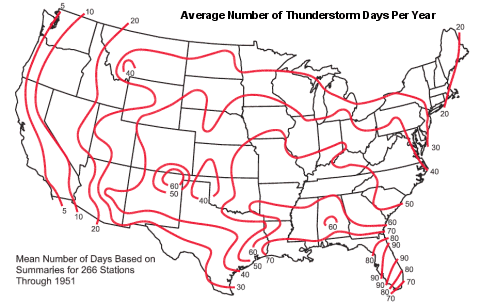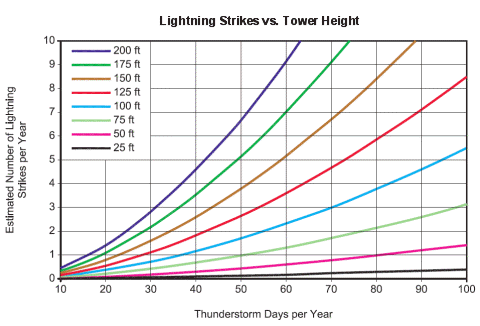Lightning Protection
By: Rob Beckers
Lightning looks for the path of least resistance to ground. That tall metal tower with your wind turbine on top, at least 60 feet high, and sticking out at least 30 feet over everything else in a wide area around it (that is, if you sited your turbine properly!), may very well be that easiest path. While insurance companies lump lightning in with “Acts of God”, we prefer not to rely on higher powers to keep our wind turbine, and especially those associated expensive electronics, from getting converted to scrap metal when lightning hits. Fortunately there is quite a bit that can be done to make your wind turbine, and the electronics such as the inverter, safe from lightning damage!
By using a combination of proper grounding, proper wiring, plus lightning and surge arrestors you can change the odds decidedly in your favour. Not only for wind turbines, but for any item susceptible to lightning or surges, such as solar (PV) panels, and your grid service entrance. This information is not only useful in mitigating lightning damage, it works just as well for ‘regular’ grid surges. Contaminated grid power is a much more common source of stress or failure for electronic equipment than lightning. Since insurance was mentioned: Most home owner insurance policies will insure renewable energy sources such as solar panels and wind turbines against lightning damage. It is important to talk to your insurance broker about this, since there is no iron-clad guarantee when it comes to lightning that there will be no damage from a strike. Even when you do all the right things.
The information in these pages was extracted from many different sources on lightning protection and grounding of wind turbines, professional communications towers, and HAM radio towers and equipment. It gives an overview of ‘best practices’ and should not be regarded as a blue-print for your particular installation. Rather, it is intended to convey a way of thinking when it comes to lightning protection that allows you to do the best job you can with the means available to you.
Protection against lightning consists of several major parts that all need to be done right to be effective:
- Proper grounding of the tower and equipment
- Proper routing, shielding and grouping of cables and equipment
- Effective lightning and surge arrestors
- Making it work in the real world, with the means available to you
 The map on the right shows the average number of days that have lightning for a given area. It gives some idea of what to expect for your area, but it is pretty coarse. If you live in a mountainous area you already know that terrain can play its part to make lightning more likely for your location. For Canadian locations close to the US border just extrapolate from the map.
The map on the right shows the average number of days that have lightning for a given area. It gives some idea of what to expect for your area, but it is pretty coarse. If you live in a mountainous area you already know that terrain can play its part to make lightning more likely for your location. For Canadian locations close to the US border just extrapolate from the map.
The number of lightning days is half the story. The tower height also determines how likely a lightning strike is. The next figure puts a number to that. It should really be stressed that this is a crude approximation of the real odds of a wind turbine getting hit by lightning. It does give a number though, and therefore some measure of what to expect. As always, your mileage (or hits, as it were) may vary. Lightning does not read the charts and your turbine may get hit tomorrow, or not al all for years to come. It is all about statistics.

Protecting against lightning and, more in general, power surge damage is not an all-or-nothing choice. There are many shades of gray, or should we say the color of the currency of your choice. The spectrum runs from doing nothing (in which case you better be on friendly terms with the God(s) of your choice), all the way to a grounding network around your tower and structures, with industrial quality lightning and surge arrestors to top it off. Unfortunately, as the quality of protection increases, so does the money needed to get there. When done right, it is quite amazing what level of protection money can buy; the communications towers used by the pros get hit by lightning on a regular basis, and those towers can almost always take direct hits without any damage to the tower, antennas, or electronics. Note the word “almost”. There are no guarantees when it comes to lightning, only degrees of protection. Even the Pros have the occasional bad day. Still, designing and installing with lightning protection in mind will greatly improve your odds of surviving a direct or indirect hit without damage.
By the way, did you know that making your renewable energy installation lightning proof will help ‘harden’ it to some degree for certain types of EMP. That is electromagnetic pulse, the by-product of a nuclear explosion designed to knock out electronics and communications. Lightning and EMP do very similar things to equipment, and proper lightning protection will go a long way towards EMP protection. The difference is that lightning strikes have an effect up to a few miles, while EMP can destroy equipment thousands of miles away.
Links, Notes, and Papers
- Dehn’s ABC’s of Lightning
- ARRL lightning protection information for Amateur Radio
- Practical testimony on the difference a proper grounding system can make
- Erico’s Practical Guide to Electrical Grounding
- More about Ufer grounds, and another Ufer ground page
- The NEC about tower grounding
- Interesting lecture slides about exothermic welds and grounding, with pictures
- NREL publication 31115 – Wind Turbine Lightning Protection Project
- AT&T on grounding Internet Service Facilities
- Brite Products cold galvanizing spray
Polyphaser/Transtector white papers
- AC and DC power protection at communications sites
- An overview of lightning protection for ham radio stations
- Clamping game
- Coaxial cable entry panels and coax grounding
- Coaxial cable lightning protectors
- Corrosion protection for tower structures
- Dissimilar metals may take away your protection
- Does your equipment room have a single point ground
- Earth ground measurements
- Equipment rack grounding
- Fuse confusion
- Ground impedance
- Ground rod theory installation
- Grounding and materials
- Halo grounds
- How to ground the coaxial cable shields as they enter the equipment building
- Insulated support structures
- Lightning protection location
- Lightning protector surge current ratings
- Protecting Equipment for EMP damage
- Roof top site grounding
- Security cameras CATV GPS and satellite protection
- Telephone network and computer interfaces at communications sites
- The best RF protector for applications not requiring DC on the coax
- The lightning event
- Tower strikes and solutions
- Where the lightning energy goes and what can happen
MTL Surge Technologies white papers
- Earthing guide for surge protection
- Lightning and surge protection basic principles
- Lightning and surge protection for fieldbus systems
- Lightning surge protection for electronic equipment
- Surge protection for electrical power installations
- Surge protection for intrinsically safe systems
- Surge protection for local area networks
- Surge protection for weighing systems
- Surge protection for Zone 0 locations
Surge arrestor manufacturers
- Dehn
- MTL Surge Technologies
- Polyphaser/Transtector Corporation
- Delta Lightning Arrestors
- MCG Surge Protection
| Go to next: Proper grounding of the tower and equipment. |





